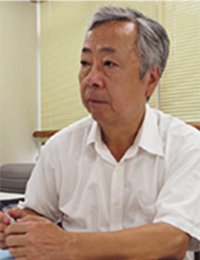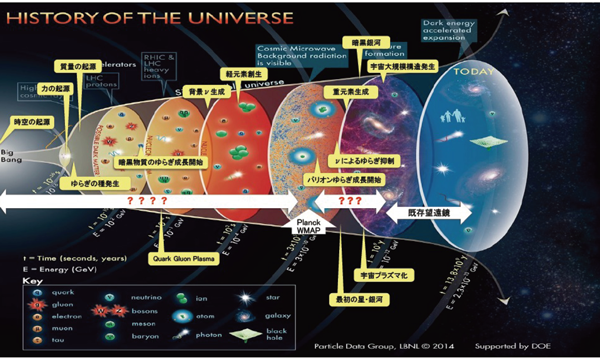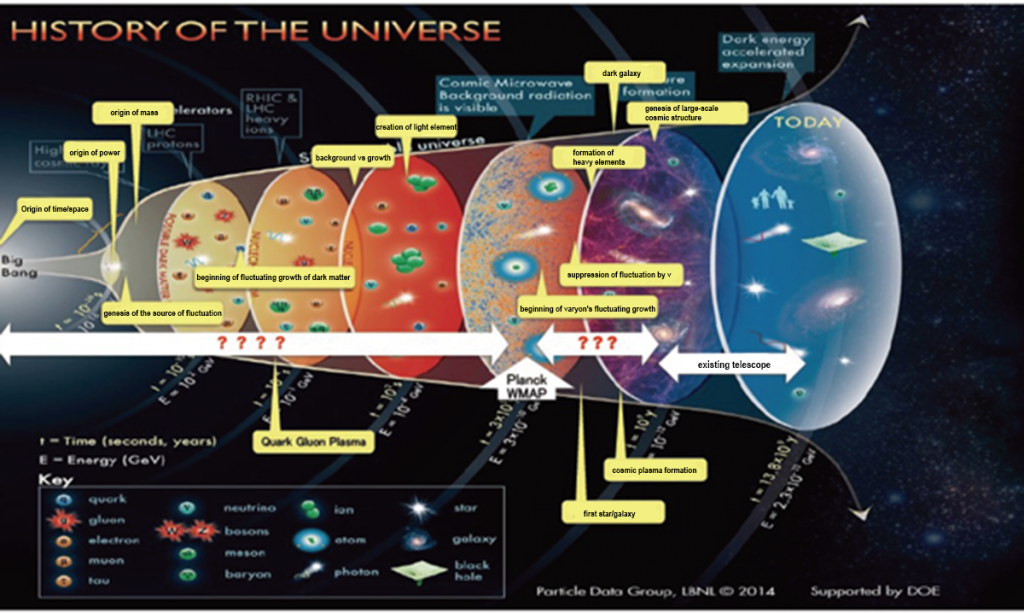他のメンバー : 原 和彦 後藤 博正 江角 晋一 笹 公和 山村 泰久 受川 史彦 小沢 顕 小林 航 渡辺 紀生 柳原 英人 櫻井 岳暁 齋藤 一弥
キーワード: 宇宙史、粒子加速器、粒子検出器、宇宙背景ニュートリノ、ヒッグス粒子、クォークグルオンプラズマ
 筑波大・KEK(高エネルギー加速器研究機構)連携による国際共同研究によって、宇宙背景ニュートリノ崩壊探索、世界最高エネルギーのLHC 加速器を用いた質量起源の解明とクォークグルオンプラズマ(QGP) の研究、ブラックホール・銀河形成の研究を推進して宇宙・物質の階層と歴史(図1)の解明に貢献しています。また、ナノテクノロジーやグリーンテクノロジ分野における教育研究を推進しています。
筑波大・KEK(高エネルギー加速器研究機構)連携による国際共同研究によって、宇宙背景ニュートリノ崩壊探索、世界最高エネルギーのLHC 加速器を用いた質量起源の解明とクォークグルオンプラズマ(QGP) の研究、ブラックホール・銀河形成の研究を推進して宇宙・物質の階層と歴史(図1)の解明に貢献しています。また、ナノテクノロジーやグリーンテクノロジ分野における教育研究を推進しています。

図1:宇宙史。横軸が時間軸、縦軸が空間軸で、ビッグバン宇宙の膨張とともに、相が変わっていくことを示す。
国際教育研究拠点の形成
私たちは、宇宙史研究を行うために、欧州CERN 研究所、米国FNAL 研究所、BNL 研究所に海外拠点を置き、学生がそれら拠点で外国人研究者らとの長期共同研究を行う「宇宙史一貫教育プログラム」(H19 〜) を進めてきました。H26 創設の「数理物質融合科学センター」では、宇宙史国際研究拠点と環境エネルギー材料研究拠点が融合し、国際的な南極天文コンソーシアム・宇宙史コンソーシアム(図2)の枠組みを作り、素粒子・原子核・宇宙研究を、ビッグバンから膨張宇宙に至る宇宙史の中で再構築し、暗黒物質・エネルギーの解明、宇宙進化・物質起源の研究を推進しています。

図2:宇宙史コンソーシアム。筑波大学が中核となって、国内・海外の研究機関が連携して宇宙史の統一的理解を目指した融合研究を推進している。
新型粒子検出器の開発研究
宇宙史研究のための粒子検出器(下記)をKEK と共同開発しています。
- 宇宙背景ニュートリノ崩壊を検知する超伝導トンネル接合素子(STJ) 赤外線検出器
- ヒッグス粒子研究のためのSOI ピクセル飛跡検出器
- クォークグルオンプラズマ研究のためのシリコン電磁カロリメータ検出器・MRPC 飛行時間測定器 TIA-ACCELERATE とも連携
社会への貢献・実績
- 日本学術会議の策定の第22 期大型研究計画マスタープランに私たちの推進する宇宙背景ニュートリノ崩壊探索、 南極天文台、ALICE 実験、ATLAS 実験、RIBF 実験の5つのプロジェクト(先頭3つは中核機関=筑波大)が採択。
- 素粒子原子核分野に限らず物質科学・生命科学分野や医療分野でも重要な加速器科学での人材を育成。
取材:平成27年8月31日
Clarification of Universe History with Particle Accelerators and Particle Detection Technology
Unit members : Hara, Kazuhiko Goto, Hiromasa Esumi, ShinIchi Sasa, Kimikazu Yamamura, Yasuhisa Ukegawa, Fumihiko Ozawa, Akira Kobayashi, Wataru Watanabe, Norio Yanagihara, Hideto SAKURAI, TAKEAKI Saito, Kazuya
Unit name: International Research and Education Center in Cooperation with KEK
Key words: universe history, particle accelerator, particle detector, cosmic background neutrino, higgs particle, quark-gluon plasma
 International cooperative research including the University of Tsukuba and KEK (High Energy Accelerator Research Organization) has been contributing to the elucidation of the hierarchy and the history of the space and the matter. Our strategy includes the study of the cosmic background neutrino decay, the elucidation of the origin of the mass and the quark-gluon plasma (QGP) with the world’s highest energy LHC accelerator, as well as the study of the black hole and galaxy formation. We have also been promoting education and research in the fields of nanotechnology and green technology.
International cooperative research including the University of Tsukuba and KEK (High Energy Accelerator Research Organization) has been contributing to the elucidation of the hierarchy and the history of the space and the matter. Our strategy includes the study of the cosmic background neutrino decay, the elucidation of the origin of the mass and the quark-gluon plasma (QGP) with the world’s highest energy LHC accelerator, as well as the study of the black hole and galaxy formation. We have also been promoting education and research in the fields of nanotechnology and green technology.

Fig. 1: Universe history. Universe (Y axis) is plotted against time (X axis). The phase changes as the cosmos expands after big bang.
Establishment of National Education and Research Center
To study the history of the universe, we set our overseas research stations at several institutes, including CERN in Europe and FINAL and BNL in the USA, where we have been running the “Continued Education Program named The History of the Universe” since 2007, where our students conduct long-term overseas joint researches. The Center for Integrated Research in Fundamental Science and Engineering (CiRfSE) was founded in 2014, when the two institutes, the history of the universe international research center and the environmental energy and material research center, were combined. We established a global framework as the Consortium of Antarctic Astronomy and the Consortium of the History of the Universe (Fig. 2), in which we restructured the researches on elementary particles, atomic nuclei and the space in the context of the history of universe beginning with the big bang and continuing on the present cosmic expansion. We then explore the cosmic evolution and the origin of the matters.

Fig. 2: Consortium of Universe History
Development of a New Type of Particle Detector
Jointly with KEK, we are developing a particle detector described below to study the history of the universe .
- Superconducting tunnel junction (STJ) infrared detector for sensing cosmic background neutrino decay
- SOI pixel track detector for research on the Higgs boson
- Silicone electromagnetic colorimetric detector/MRPC flight time measuring device for research on quark-gluon plasma (in cooperation with TIA-ACCELERATE)
Social contributions and achievements
- The 22nd master plan on large-scale research, devised by the Science Council of Japan, adopted five of our projects (cosmic background neutrino decay exploration, Antarctic observatory, ALICE experiment, ATLAS experiment and RIBF experiment; University of Tsukuba was the core institution of the first 3 projects).
- Cultivation of researchers of accelerator science, which is important not only for the particle and nuclear physics but also for the fields of material science, life science and healthcare.
Interviewed on August 31, 2015
